International Tourism Consultancy: Sustainable Tourism Report
VerifiedAdded on 2020/07/22
|15
|4930
|75
Report
AI Summary
This report, prepared for International Tourism Consultancy, explores sustainable tourism development, focusing on stakeholder benefits and strategic planning. It examines the advantages and disadvantages of public-private partnerships in tourism and delves into various features of tourism development planning at different levels, including international, national, regional, and sub-regional. The report emphasizes the significance of interactive planning systems and processes in fostering effective tourism development, along with different methods used to measure tourist impact, such as economic impact models and the Cambridge Economic Impact Model. The report also addresses conflict resolution, balancing supply and demand, and ethical issues within enclave tourism. Finally, it compares current issues in developing and emerging tourism destinations and provides recommendations for the future development of tourism.

Sustainable Tourism
Development
Development
Paraphrase This Document
Need a fresh take? Get an instant paraphrase of this document with our AI Paraphraser
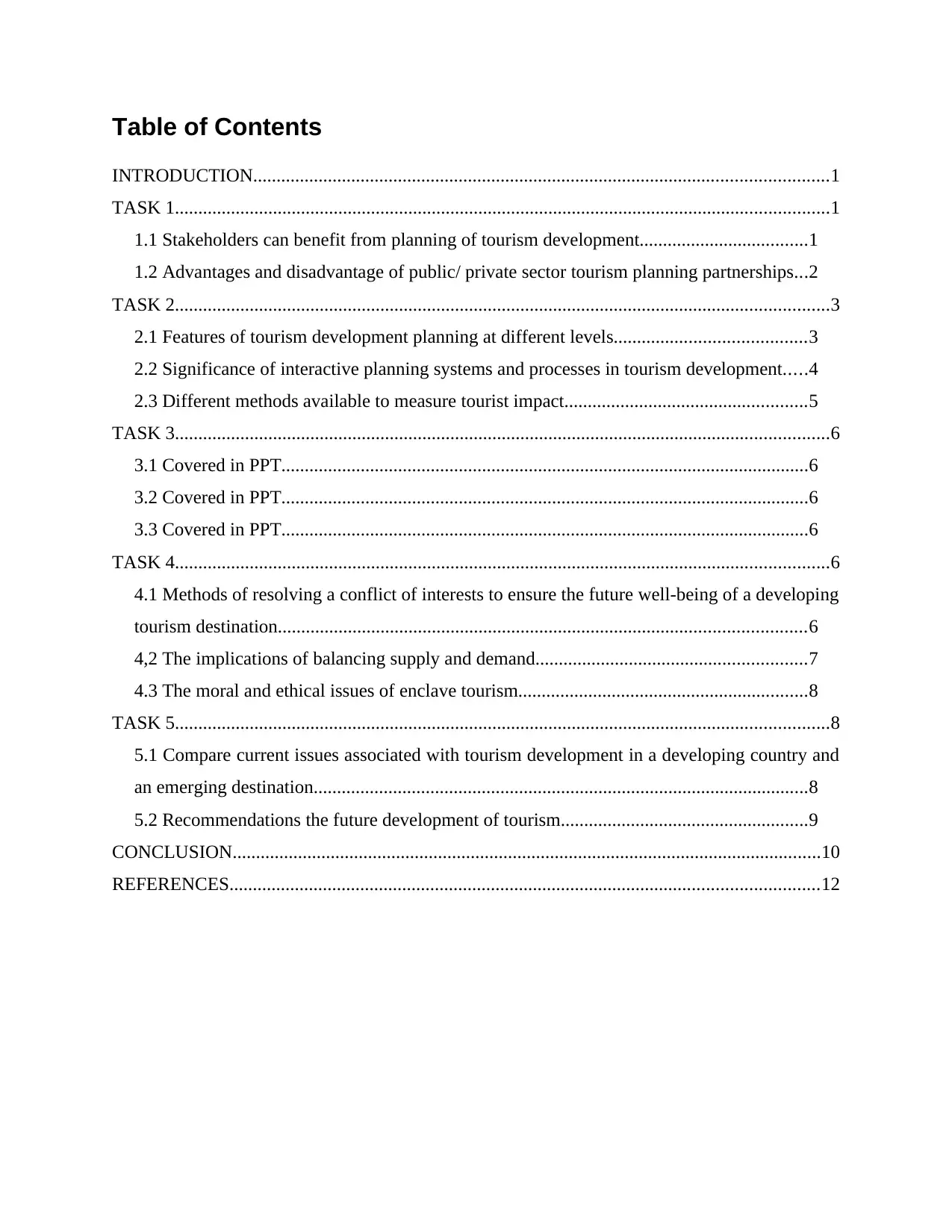
Table of Contents
INTRODUCTION...........................................................................................................................1
TASK 1............................................................................................................................................1
1.1 Stakeholders can benefit from planning of tourism development....................................1
1.2 Advantages and disadvantage of public/ private sector tourism planning partnerships...2
TASK 2............................................................................................................................................3
2.1 Features of tourism development planning at different levels.........................................3
2.2 Significance of interactive planning systems and processes in tourism development.....4
2.3 Different methods available to measure tourist impact....................................................5
TASK 3............................................................................................................................................6
3.1 Covered in PPT.................................................................................................................6
3.2 Covered in PPT.................................................................................................................6
3.3 Covered in PPT.................................................................................................................6
TASK 4............................................................................................................................................6
4.1 Methods of resolving a conflict of interests to ensure the future well-being of a developing
tourism destination.................................................................................................................6
4,2 The implications of balancing supply and demand..........................................................7
4.3 The moral and ethical issues of enclave tourism..............................................................8
TASK 5............................................................................................................................................8
5.1 Compare current issues associated with tourism development in a developing country and
an emerging destination..........................................................................................................8
5.2 Recommendations the future development of tourism.....................................................9
CONCLUSION..............................................................................................................................10
REFERENCES..............................................................................................................................12
INTRODUCTION...........................................................................................................................1
TASK 1............................................................................................................................................1
1.1 Stakeholders can benefit from planning of tourism development....................................1
1.2 Advantages and disadvantage of public/ private sector tourism planning partnerships...2
TASK 2............................................................................................................................................3
2.1 Features of tourism development planning at different levels.........................................3
2.2 Significance of interactive planning systems and processes in tourism development.....4
2.3 Different methods available to measure tourist impact....................................................5
TASK 3............................................................................................................................................6
3.1 Covered in PPT.................................................................................................................6
3.2 Covered in PPT.................................................................................................................6
3.3 Covered in PPT.................................................................................................................6
TASK 4............................................................................................................................................6
4.1 Methods of resolving a conflict of interests to ensure the future well-being of a developing
tourism destination.................................................................................................................6
4,2 The implications of balancing supply and demand..........................................................7
4.3 The moral and ethical issues of enclave tourism..............................................................8
TASK 5............................................................................................................................................8
5.1 Compare current issues associated with tourism development in a developing country and
an emerging destination..........................................................................................................8
5.2 Recommendations the future development of tourism.....................................................9
CONCLUSION..............................................................................................................................10
REFERENCES..............................................................................................................................12
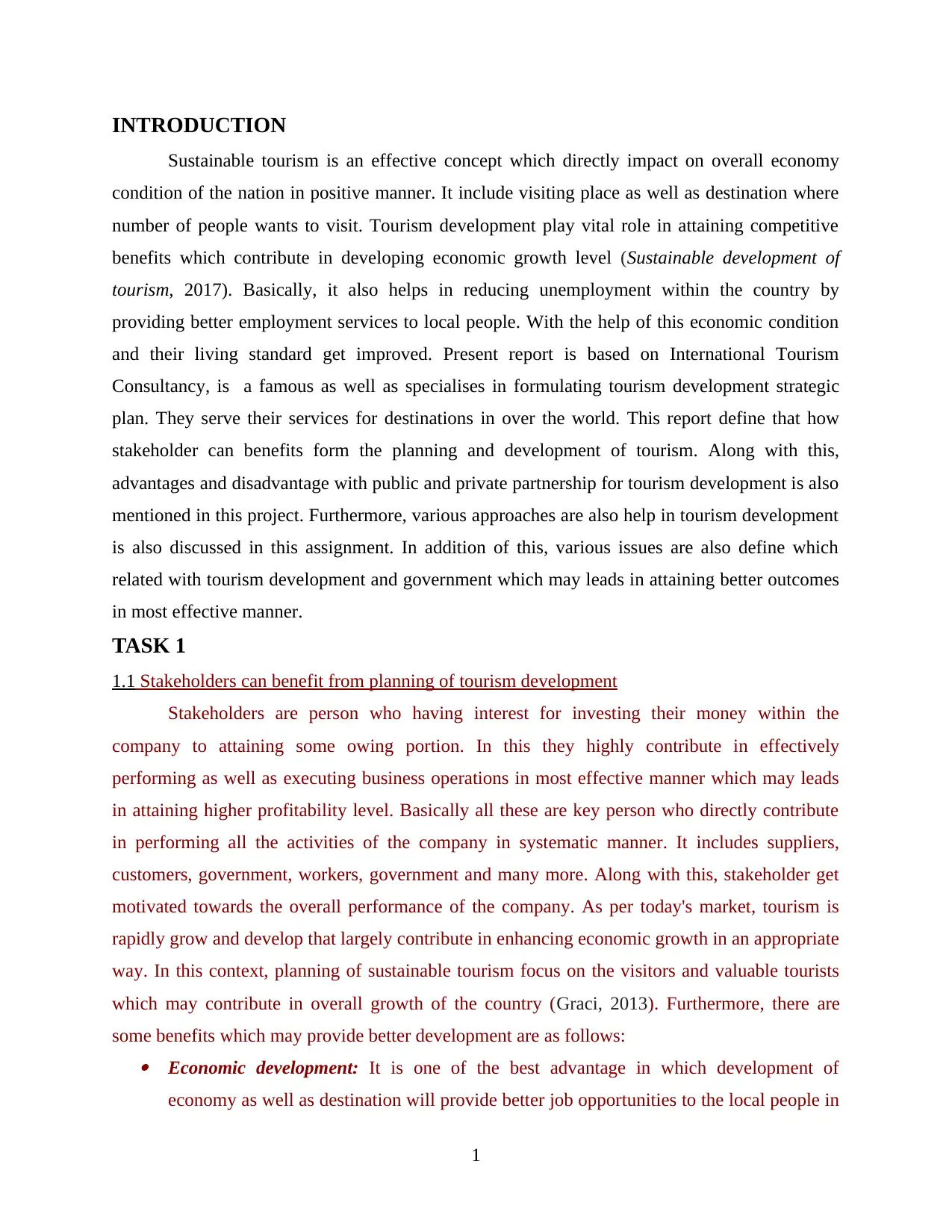
INTRODUCTION
Sustainable tourism is an effective concept which directly impact on overall economy
condition of the nation in positive manner. It include visiting place as well as destination where
number of people wants to visit. Tourism development play vital role in attaining competitive
benefits which contribute in developing economic growth level (Sustainable development of
tourism, 2017). Basically, it also helps in reducing unemployment within the country by
providing better employment services to local people. With the help of this economic condition
and their living standard get improved. Present report is based on International Tourism
Consultancy, is a famous as well as specialises in formulating tourism development strategic
plan. They serve their services for destinations in over the world. This report define that how
stakeholder can benefits form the planning and development of tourism. Along with this,
advantages and disadvantage with public and private partnership for tourism development is also
mentioned in this project. Furthermore, various approaches are also help in tourism development
is also discussed in this assignment. In addition of this, various issues are also define which
related with tourism development and government which may leads in attaining better outcomes
in most effective manner.
TASK 1
1.1 Stakeholders can benefit from planning of tourism development
Stakeholders are person who having interest for investing their money within the
company to attaining some owing portion. In this they highly contribute in effectively
performing as well as executing business operations in most effective manner which may leads
in attaining higher profitability level. Basically all these are key person who directly contribute
in performing all the activities of the company in systematic manner. It includes suppliers,
customers, government, workers, government and many more. Along with this, stakeholder get
motivated towards the overall performance of the company. As per today's market, tourism is
rapidly grow and develop that largely contribute in enhancing economic growth in an appropriate
way. In this context, planning of sustainable tourism focus on the visitors and valuable tourists
which may contribute in overall growth of the country (Graci, 2013). Furthermore, there are
some benefits which may provide better development are as follows: Economic development: It is one of the best advantage in which development of
economy as well as destination will provide better job opportunities to the local people in
1
Sustainable tourism is an effective concept which directly impact on overall economy
condition of the nation in positive manner. It include visiting place as well as destination where
number of people wants to visit. Tourism development play vital role in attaining competitive
benefits which contribute in developing economic growth level (Sustainable development of
tourism, 2017). Basically, it also helps in reducing unemployment within the country by
providing better employment services to local people. With the help of this economic condition
and their living standard get improved. Present report is based on International Tourism
Consultancy, is a famous as well as specialises in formulating tourism development strategic
plan. They serve their services for destinations in over the world. This report define that how
stakeholder can benefits form the planning and development of tourism. Along with this,
advantages and disadvantage with public and private partnership for tourism development is also
mentioned in this project. Furthermore, various approaches are also help in tourism development
is also discussed in this assignment. In addition of this, various issues are also define which
related with tourism development and government which may leads in attaining better outcomes
in most effective manner.
TASK 1
1.1 Stakeholders can benefit from planning of tourism development
Stakeholders are person who having interest for investing their money within the
company to attaining some owing portion. In this they highly contribute in effectively
performing as well as executing business operations in most effective manner which may leads
in attaining higher profitability level. Basically all these are key person who directly contribute
in performing all the activities of the company in systematic manner. It includes suppliers,
customers, government, workers, government and many more. Along with this, stakeholder get
motivated towards the overall performance of the company. As per today's market, tourism is
rapidly grow and develop that largely contribute in enhancing economic growth in an appropriate
way. In this context, planning of sustainable tourism focus on the visitors and valuable tourists
which may contribute in overall growth of the country (Graci, 2013). Furthermore, there are
some benefits which may provide better development are as follows: Economic development: It is one of the best advantage in which development of
economy as well as destination will provide better job opportunities to the local people in
1
⊘ This is a preview!⊘
Do you want full access?
Subscribe today to unlock all pages.

Trusted by 1+ million students worldwide
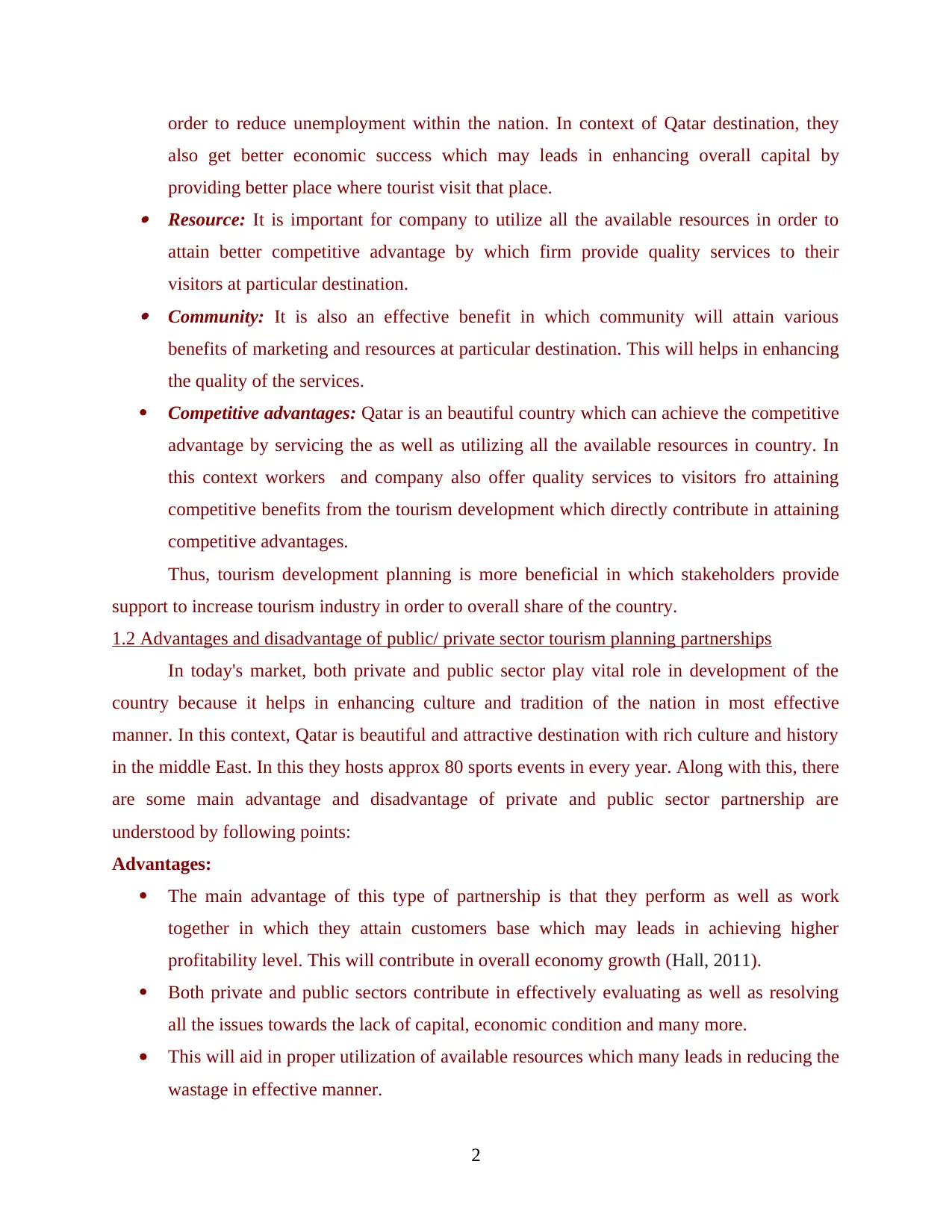
order to reduce unemployment within the nation. In context of Qatar destination, they
also get better economic success which may leads in enhancing overall capital by
providing better place where tourist visit that place. Resource: It is important for company to utilize all the available resources in order to
attain better competitive advantage by which firm provide quality services to their
visitors at particular destination. Community: It is also an effective benefit in which community will attain various
benefits of marketing and resources at particular destination. This will helps in enhancing
the quality of the services.
Competitive advantages: Qatar is an beautiful country which can achieve the competitive
advantage by servicing the as well as utilizing all the available resources in country. In
this context workers and company also offer quality services to visitors fro attaining
competitive benefits from the tourism development which directly contribute in attaining
competitive advantages.
Thus, tourism development planning is more beneficial in which stakeholders provide
support to increase tourism industry in order to overall share of the country.
1.2 Advantages and disadvantage of public/ private sector tourism planning partnerships
In today's market, both private and public sector play vital role in development of the
country because it helps in enhancing culture and tradition of the nation in most effective
manner. In this context, Qatar is beautiful and attractive destination with rich culture and history
in the middle East. In this they hosts approx 80 sports events in every year. Along with this, there
are some main advantage and disadvantage of private and public sector partnership are
understood by following points:
Advantages:
The main advantage of this type of partnership is that they perform as well as work
together in which they attain customers base which may leads in achieving higher
profitability level. This will contribute in overall economy growth (Hall, 2011).
Both private and public sectors contribute in effectively evaluating as well as resolving
all the issues towards the lack of capital, economic condition and many more.
This will aid in proper utilization of available resources which many leads in reducing the
wastage in effective manner.
2
also get better economic success which may leads in enhancing overall capital by
providing better place where tourist visit that place. Resource: It is important for company to utilize all the available resources in order to
attain better competitive advantage by which firm provide quality services to their
visitors at particular destination. Community: It is also an effective benefit in which community will attain various
benefits of marketing and resources at particular destination. This will helps in enhancing
the quality of the services.
Competitive advantages: Qatar is an beautiful country which can achieve the competitive
advantage by servicing the as well as utilizing all the available resources in country. In
this context workers and company also offer quality services to visitors fro attaining
competitive benefits from the tourism development which directly contribute in attaining
competitive advantages.
Thus, tourism development planning is more beneficial in which stakeholders provide
support to increase tourism industry in order to overall share of the country.
1.2 Advantages and disadvantage of public/ private sector tourism planning partnerships
In today's market, both private and public sector play vital role in development of the
country because it helps in enhancing culture and tradition of the nation in most effective
manner. In this context, Qatar is beautiful and attractive destination with rich culture and history
in the middle East. In this they hosts approx 80 sports events in every year. Along with this, there
are some main advantage and disadvantage of private and public sector partnership are
understood by following points:
Advantages:
The main advantage of this type of partnership is that they perform as well as work
together in which they attain customers base which may leads in achieving higher
profitability level. This will contribute in overall economy growth (Hall, 2011).
Both private and public sectors contribute in effectively evaluating as well as resolving
all the issues towards the lack of capital, economic condition and many more.
This will aid in proper utilization of available resources which many leads in reducing the
wastage in effective manner.
2
Paraphrase This Document
Need a fresh take? Get an instant paraphrase of this document with our AI Paraphraser
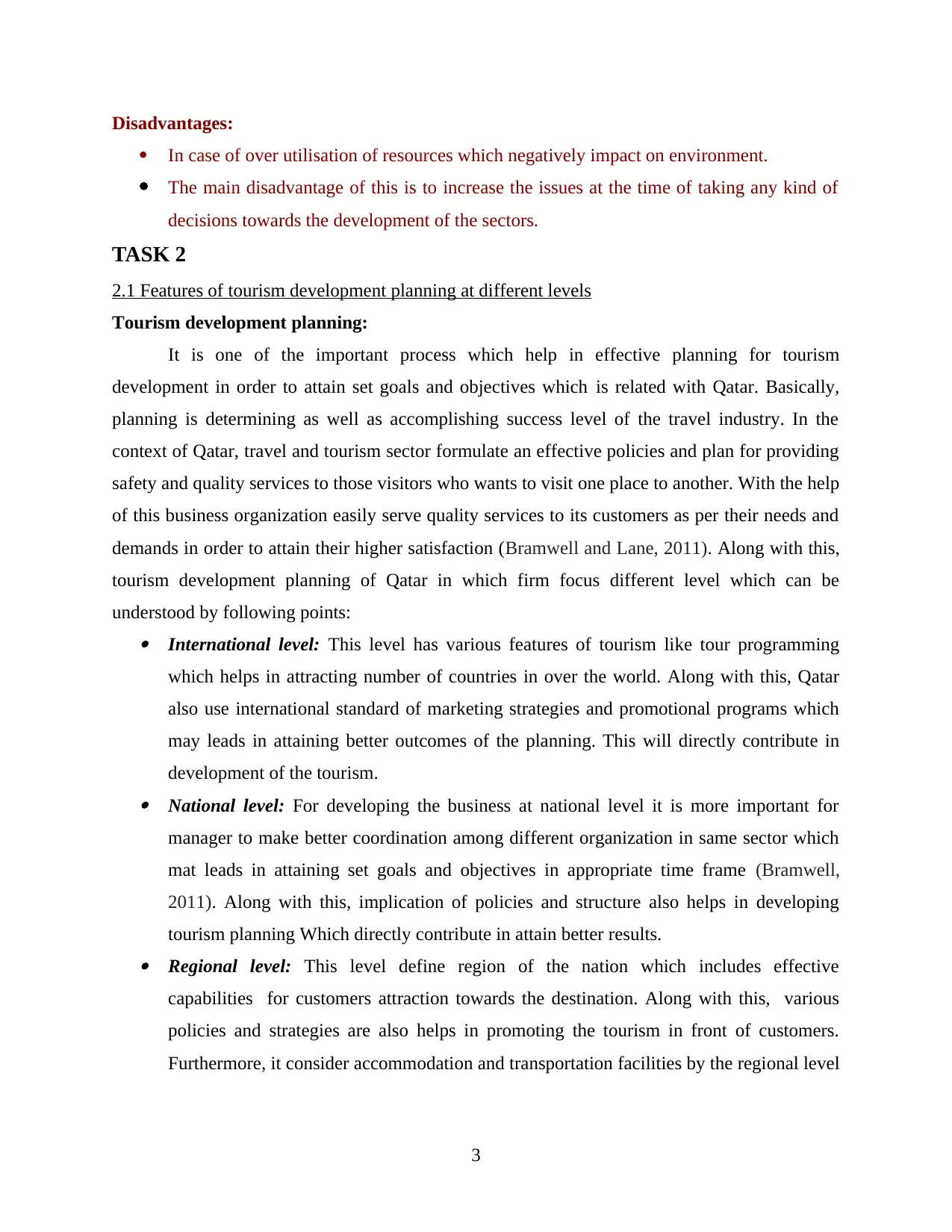
Disadvantages:
In case of over utilisation of resources which negatively impact on environment.
The main disadvantage of this is to increase the issues at the time of taking any kind of
decisions towards the development of the sectors.
TASK 2
2.1 Features of tourism development planning at different levels
Tourism development planning:
It is one of the important process which help in effective planning for tourism
development in order to attain set goals and objectives which is related with Qatar. Basically,
planning is determining as well as accomplishing success level of the travel industry. In the
context of Qatar, travel and tourism sector formulate an effective policies and plan for providing
safety and quality services to those visitors who wants to visit one place to another. With the help
of this business organization easily serve quality services to its customers as per their needs and
demands in order to attain their higher satisfaction (Bramwell and Lane, 2011). Along with this,
tourism development planning of Qatar in which firm focus different level which can be
understood by following points: International level: This level has various features of tourism like tour programming
which helps in attracting number of countries in over the world. Along with this, Qatar
also use international standard of marketing strategies and promotional programs which
may leads in attaining better outcomes of the planning. This will directly contribute in
development of the tourism. National level: For developing the business at national level it is more important for
manager to make better coordination among different organization in same sector which
mat leads in attaining set goals and objectives in appropriate time frame (Bramwell,
2011). Along with this, implication of policies and structure also helps in developing
tourism planning Which directly contribute in attain better results. Regional level: This level define region of the nation which includes effective
capabilities for customers attraction towards the destination. Along with this, various
policies and strategies are also helps in promoting the tourism in front of customers.
Furthermore, it consider accommodation and transportation facilities by the regional level
3
In case of over utilisation of resources which negatively impact on environment.
The main disadvantage of this is to increase the issues at the time of taking any kind of
decisions towards the development of the sectors.
TASK 2
2.1 Features of tourism development planning at different levels
Tourism development planning:
It is one of the important process which help in effective planning for tourism
development in order to attain set goals and objectives which is related with Qatar. Basically,
planning is determining as well as accomplishing success level of the travel industry. In the
context of Qatar, travel and tourism sector formulate an effective policies and plan for providing
safety and quality services to those visitors who wants to visit one place to another. With the help
of this business organization easily serve quality services to its customers as per their needs and
demands in order to attain their higher satisfaction (Bramwell and Lane, 2011). Along with this,
tourism development planning of Qatar in which firm focus different level which can be
understood by following points: International level: This level has various features of tourism like tour programming
which helps in attracting number of countries in over the world. Along with this, Qatar
also use international standard of marketing strategies and promotional programs which
may leads in attaining better outcomes of the planning. This will directly contribute in
development of the tourism. National level: For developing the business at national level it is more important for
manager to make better coordination among different organization in same sector which
mat leads in attaining set goals and objectives in appropriate time frame (Bramwell,
2011). Along with this, implication of policies and structure also helps in developing
tourism planning Which directly contribute in attain better results. Regional level: This level define region of the nation which includes effective
capabilities for customers attraction towards the destination. Along with this, various
policies and strategies are also helps in promoting the tourism in front of customers.
Furthermore, it consider accommodation and transportation facilities by the regional level
3
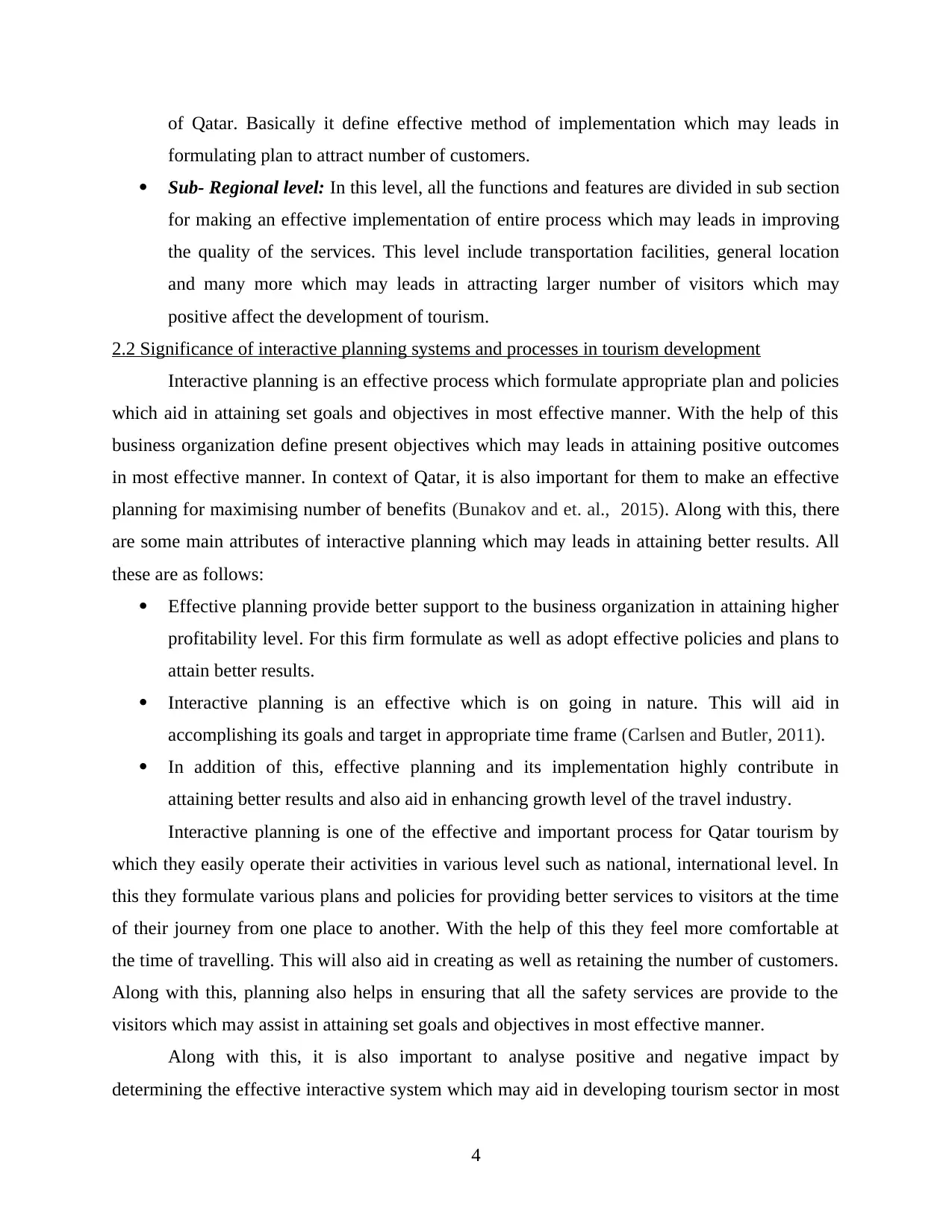
of Qatar. Basically it define effective method of implementation which may leads in
formulating plan to attract number of customers.
Sub- Regional level: In this level, all the functions and features are divided in sub section
for making an effective implementation of entire process which may leads in improving
the quality of the services. This level include transportation facilities, general location
and many more which may leads in attracting larger number of visitors which may
positive affect the development of tourism.
2.2 Significance of interactive planning systems and processes in tourism development
Interactive planning is an effective process which formulate appropriate plan and policies
which aid in attaining set goals and objectives in most effective manner. With the help of this
business organization define present objectives which may leads in attaining positive outcomes
in most effective manner. In context of Qatar, it is also important for them to make an effective
planning for maximising number of benefits (Bunakov and et. al., 2015). Along with this, there
are some main attributes of interactive planning which may leads in attaining better results. All
these are as follows:
Effective planning provide better support to the business organization in attaining higher
profitability level. For this firm formulate as well as adopt effective policies and plans to
attain better results.
Interactive planning is an effective which is on going in nature. This will aid in
accomplishing its goals and target in appropriate time frame (Carlsen and Butler, 2011).
In addition of this, effective planning and its implementation highly contribute in
attaining better results and also aid in enhancing growth level of the travel industry.
Interactive planning is one of the effective and important process for Qatar tourism by
which they easily operate their activities in various level such as national, international level. In
this they formulate various plans and policies for providing better services to visitors at the time
of their journey from one place to another. With the help of this they feel more comfortable at
the time of travelling. This will also aid in creating as well as retaining the number of customers.
Along with this, planning also helps in ensuring that all the safety services are provide to the
visitors which may assist in attaining set goals and objectives in most effective manner.
Along with this, it is also important to analyse positive and negative impact by
determining the effective interactive system which may aid in developing tourism sector in most
4
formulating plan to attract number of customers.
Sub- Regional level: In this level, all the functions and features are divided in sub section
for making an effective implementation of entire process which may leads in improving
the quality of the services. This level include transportation facilities, general location
and many more which may leads in attracting larger number of visitors which may
positive affect the development of tourism.
2.2 Significance of interactive planning systems and processes in tourism development
Interactive planning is an effective process which formulate appropriate plan and policies
which aid in attaining set goals and objectives in most effective manner. With the help of this
business organization define present objectives which may leads in attaining positive outcomes
in most effective manner. In context of Qatar, it is also important for them to make an effective
planning for maximising number of benefits (Bunakov and et. al., 2015). Along with this, there
are some main attributes of interactive planning which may leads in attaining better results. All
these are as follows:
Effective planning provide better support to the business organization in attaining higher
profitability level. For this firm formulate as well as adopt effective policies and plans to
attain better results.
Interactive planning is an effective which is on going in nature. This will aid in
accomplishing its goals and target in appropriate time frame (Carlsen and Butler, 2011).
In addition of this, effective planning and its implementation highly contribute in
attaining better results and also aid in enhancing growth level of the travel industry.
Interactive planning is one of the effective and important process for Qatar tourism by
which they easily operate their activities in various level such as national, international level. In
this they formulate various plans and policies for providing better services to visitors at the time
of their journey from one place to another. With the help of this they feel more comfortable at
the time of travelling. This will also aid in creating as well as retaining the number of customers.
Along with this, planning also helps in ensuring that all the safety services are provide to the
visitors which may assist in attaining set goals and objectives in most effective manner.
Along with this, it is also important to analyse positive and negative impact by
determining the effective interactive system which may aid in developing tourism sector in most
4
⊘ This is a preview!⊘
Do you want full access?
Subscribe today to unlock all pages.

Trusted by 1+ million students worldwide

effective manner. In this, the impact of visitor on local community aid in enhancing the positive
impact by promoting better services. Furthermore, interactive planning is contribute in
monitoring the effectiveness of the development of the tourism in order to meeting its goals and
objectives in limited period of time.
2.3 Different methods available to measure tourist impact
It is important to measure as well as assess the impact of tourism on Qatar. For this
various methods are there, which may leads in effectively analysing the actual impact. In this,
there are several models which determine the economic impact. On the other side, one method
helps in monitoring the economic impacts with another trends. All these methods are as follows: Economic impact model: It is one of the effective model which helps in analysing the
change estimation on the tourist in the nation in value and volume aspects. Along with
this, it also used by travelling sector from generating the income from the tourism in
Qatar. All these estimation will be determine with total employments which directly
support the company for empowering the nation (Dabphet, Scott and Ruhanen, 2012). In
addition of this, this model can evaluate the direct impact by determining the number of
visitors. Basically this, is one of the important which may leads in enhancing the
employment and stability in finance in order to grab opportunities to enhance
development of tourism in Qatar. Cambridge Economic Impact Model: The Cambridge Economic Impact Model is extend
model of economic model, and it is based on top down approach that used to know the
impact on economic values through the visitors attractions (Ekinci, 2014). This model is
used to get information about the low level data, which is generated as the tourist
experience in Qatar. There are two aspects on which the economic impact is analysed
first is value and second is volume, first it determines the value of the location such as the
components that can attract the travellers, like culture, accommodations, places to visit,
etc., according to these elements, then estimated volume gives a information, that can
offers a thriving information to push tourism including the local community,
infrastructure, economic status, etc.
STEAM model: STEAM or Scarborough Tourism Economic Activity Monitor model,
provides the information about the affect through analysing the trends from the local
business that have the impact on of tourism such as hotels, attractions, tourist information
5
impact by promoting better services. Furthermore, interactive planning is contribute in
monitoring the effectiveness of the development of the tourism in order to meeting its goals and
objectives in limited period of time.
2.3 Different methods available to measure tourist impact
It is important to measure as well as assess the impact of tourism on Qatar. For this
various methods are there, which may leads in effectively analysing the actual impact. In this,
there are several models which determine the economic impact. On the other side, one method
helps in monitoring the economic impacts with another trends. All these methods are as follows: Economic impact model: It is one of the effective model which helps in analysing the
change estimation on the tourist in the nation in value and volume aspects. Along with
this, it also used by travelling sector from generating the income from the tourism in
Qatar. All these estimation will be determine with total employments which directly
support the company for empowering the nation (Dabphet, Scott and Ruhanen, 2012). In
addition of this, this model can evaluate the direct impact by determining the number of
visitors. Basically this, is one of the important which may leads in enhancing the
employment and stability in finance in order to grab opportunities to enhance
development of tourism in Qatar. Cambridge Economic Impact Model: The Cambridge Economic Impact Model is extend
model of economic model, and it is based on top down approach that used to know the
impact on economic values through the visitors attractions (Ekinci, 2014). This model is
used to get information about the low level data, which is generated as the tourist
experience in Qatar. There are two aspects on which the economic impact is analysed
first is value and second is volume, first it determines the value of the location such as the
components that can attract the travellers, like culture, accommodations, places to visit,
etc., according to these elements, then estimated volume gives a information, that can
offers a thriving information to push tourism including the local community,
infrastructure, economic status, etc.
STEAM model: STEAM or Scarborough Tourism Economic Activity Monitor model,
provides the information about the affect through analysing the trends from the local
business that have the impact on of tourism such as hotels, attractions, tourist information
5
Paraphrase This Document
Need a fresh take? Get an instant paraphrase of this document with our AI Paraphraser
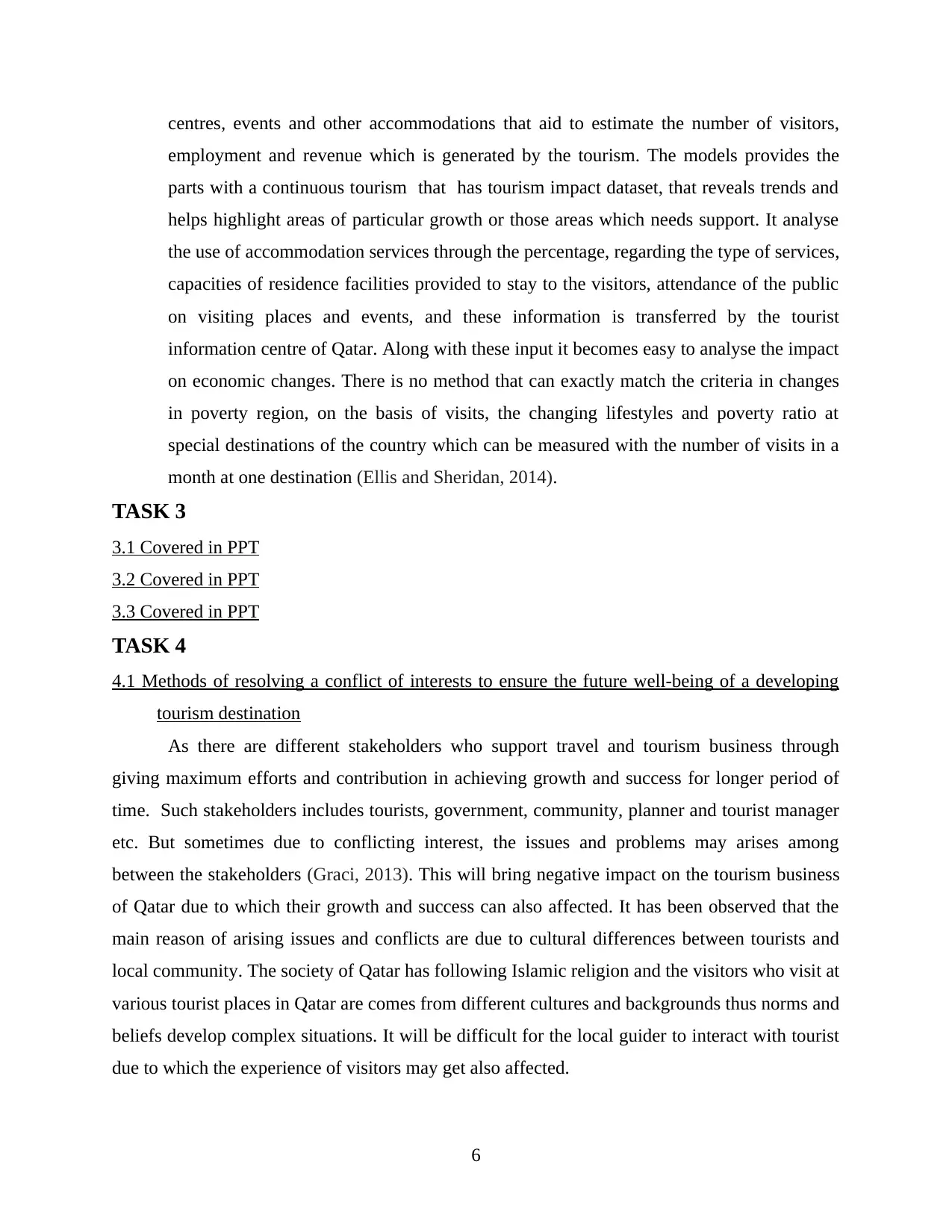
centres, events and other accommodations that aid to estimate the number of visitors,
employment and revenue which is generated by the tourism. The models provides the
parts with a continuous tourism that has tourism impact dataset, that reveals trends and
helps highlight areas of particular growth or those areas which needs support. It analyse
the use of accommodation services through the percentage, regarding the type of services,
capacities of residence facilities provided to stay to the visitors, attendance of the public
on visiting places and events, and these information is transferred by the tourist
information centre of Qatar. Along with these input it becomes easy to analyse the impact
on economic changes. There is no method that can exactly match the criteria in changes
in poverty region, on the basis of visits, the changing lifestyles and poverty ratio at
special destinations of the country which can be measured with the number of visits in a
month at one destination (Ellis and Sheridan, 2014).
TASK 3
3.1 Covered in PPT
3.2 Covered in PPT
3.3 Covered in PPT
TASK 4
4.1 Methods of resolving a conflict of interests to ensure the future well-being of a developing
tourism destination
As there are different stakeholders who support travel and tourism business through
giving maximum efforts and contribution in achieving growth and success for longer period of
time. Such stakeholders includes tourists, government, community, planner and tourist manager
etc. But sometimes due to conflicting interest, the issues and problems may arises among
between the stakeholders (Graci, 2013). This will bring negative impact on the tourism business
of Qatar due to which their growth and success can also affected. It has been observed that the
main reason of arising issues and conflicts are due to cultural differences between tourists and
local community. The society of Qatar has following Islamic religion and the visitors who visit at
various tourist places in Qatar are comes from different cultures and backgrounds thus norms and
beliefs develop complex situations. It will be difficult for the local guider to interact with tourist
due to which the experience of visitors may get also affected.
6
employment and revenue which is generated by the tourism. The models provides the
parts with a continuous tourism that has tourism impact dataset, that reveals trends and
helps highlight areas of particular growth or those areas which needs support. It analyse
the use of accommodation services through the percentage, regarding the type of services,
capacities of residence facilities provided to stay to the visitors, attendance of the public
on visiting places and events, and these information is transferred by the tourist
information centre of Qatar. Along with these input it becomes easy to analyse the impact
on economic changes. There is no method that can exactly match the criteria in changes
in poverty region, on the basis of visits, the changing lifestyles and poverty ratio at
special destinations of the country which can be measured with the number of visits in a
month at one destination (Ellis and Sheridan, 2014).
TASK 3
3.1 Covered in PPT
3.2 Covered in PPT
3.3 Covered in PPT
TASK 4
4.1 Methods of resolving a conflict of interests to ensure the future well-being of a developing
tourism destination
As there are different stakeholders who support travel and tourism business through
giving maximum efforts and contribution in achieving growth and success for longer period of
time. Such stakeholders includes tourists, government, community, planner and tourist manager
etc. But sometimes due to conflicting interest, the issues and problems may arises among
between the stakeholders (Graci, 2013). This will bring negative impact on the tourism business
of Qatar due to which their growth and success can also affected. It has been observed that the
main reason of arising issues and conflicts are due to cultural differences between tourists and
local community. The society of Qatar has following Islamic religion and the visitors who visit at
various tourist places in Qatar are comes from different cultures and backgrounds thus norms and
beliefs develop complex situations. It will be difficult for the local guider to interact with tourist
due to which the experience of visitors may get also affected.
6
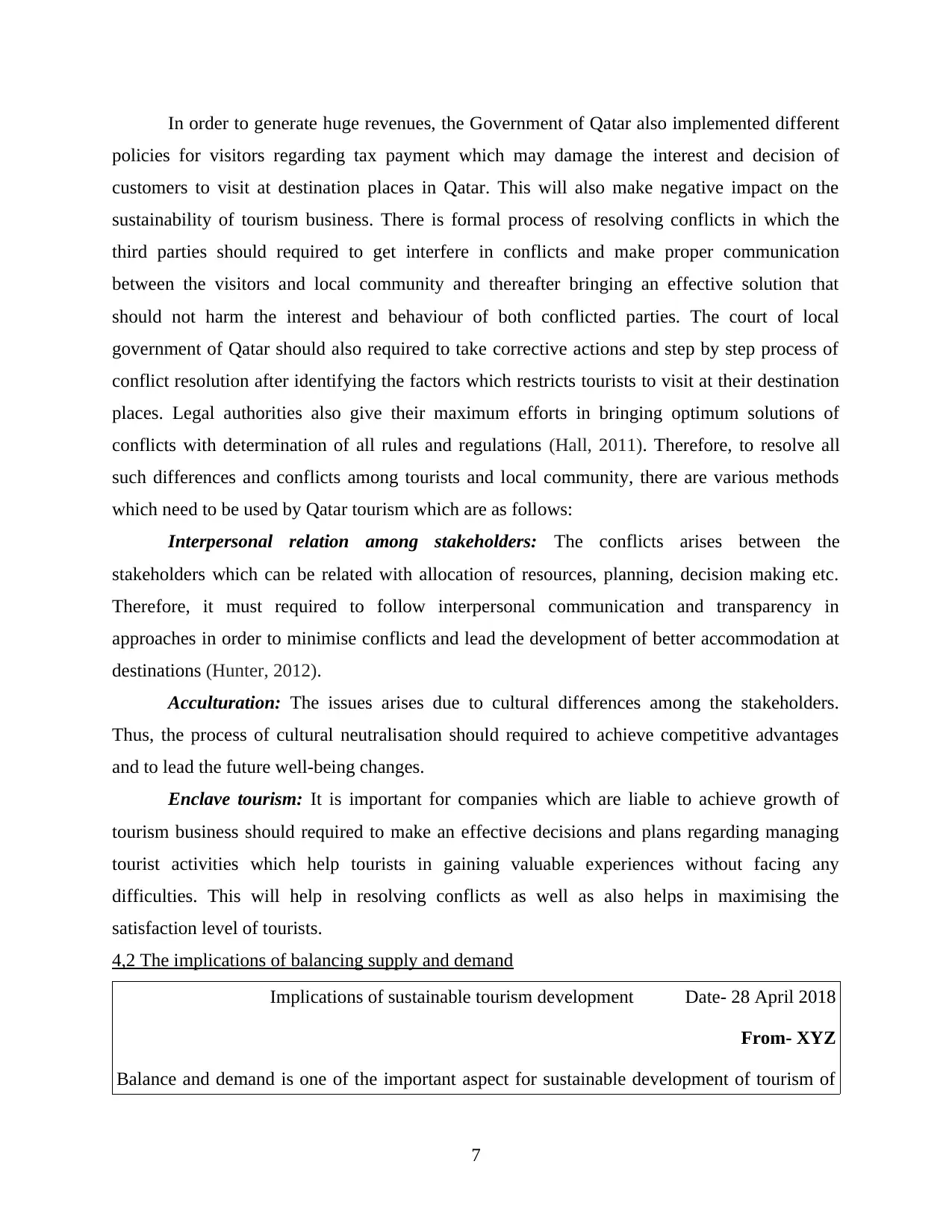
In order to generate huge revenues, the Government of Qatar also implemented different
policies for visitors regarding tax payment which may damage the interest and decision of
customers to visit at destination places in Qatar. This will also make negative impact on the
sustainability of tourism business. There is formal process of resolving conflicts in which the
third parties should required to get interfere in conflicts and make proper communication
between the visitors and local community and thereafter bringing an effective solution that
should not harm the interest and behaviour of both conflicted parties. The court of local
government of Qatar should also required to take corrective actions and step by step process of
conflict resolution after identifying the factors which restricts tourists to visit at their destination
places. Legal authorities also give their maximum efforts in bringing optimum solutions of
conflicts with determination of all rules and regulations (Hall, 2011). Therefore, to resolve all
such differences and conflicts among tourists and local community, there are various methods
which need to be used by Qatar tourism which are as follows:
Interpersonal relation among stakeholders: The conflicts arises between the
stakeholders which can be related with allocation of resources, planning, decision making etc.
Therefore, it must required to follow interpersonal communication and transparency in
approaches in order to minimise conflicts and lead the development of better accommodation at
destinations (Hunter, 2012).
Acculturation: The issues arises due to cultural differences among the stakeholders.
Thus, the process of cultural neutralisation should required to achieve competitive advantages
and to lead the future well-being changes.
Enclave tourism: It is important for companies which are liable to achieve growth of
tourism business should required to make an effective decisions and plans regarding managing
tourist activities which help tourists in gaining valuable experiences without facing any
difficulties. This will help in resolving conflicts as well as also helps in maximising the
satisfaction level of tourists.
4,2 The implications of balancing supply and demand
Implications of sustainable tourism development Date- 28 April 2018
From- XYZ
Balance and demand is one of the important aspect for sustainable development of tourism of
7
policies for visitors regarding tax payment which may damage the interest and decision of
customers to visit at destination places in Qatar. This will also make negative impact on the
sustainability of tourism business. There is formal process of resolving conflicts in which the
third parties should required to get interfere in conflicts and make proper communication
between the visitors and local community and thereafter bringing an effective solution that
should not harm the interest and behaviour of both conflicted parties. The court of local
government of Qatar should also required to take corrective actions and step by step process of
conflict resolution after identifying the factors which restricts tourists to visit at their destination
places. Legal authorities also give their maximum efforts in bringing optimum solutions of
conflicts with determination of all rules and regulations (Hall, 2011). Therefore, to resolve all
such differences and conflicts among tourists and local community, there are various methods
which need to be used by Qatar tourism which are as follows:
Interpersonal relation among stakeholders: The conflicts arises between the
stakeholders which can be related with allocation of resources, planning, decision making etc.
Therefore, it must required to follow interpersonal communication and transparency in
approaches in order to minimise conflicts and lead the development of better accommodation at
destinations (Hunter, 2012).
Acculturation: The issues arises due to cultural differences among the stakeholders.
Thus, the process of cultural neutralisation should required to achieve competitive advantages
and to lead the future well-being changes.
Enclave tourism: It is important for companies which are liable to achieve growth of
tourism business should required to make an effective decisions and plans regarding managing
tourist activities which help tourists in gaining valuable experiences without facing any
difficulties. This will help in resolving conflicts as well as also helps in maximising the
satisfaction level of tourists.
4,2 The implications of balancing supply and demand
Implications of sustainable tourism development Date- 28 April 2018
From- XYZ
Balance and demand is one of the important aspect for sustainable development of tourism of
7
⊘ This is a preview!⊘
Do you want full access?
Subscribe today to unlock all pages.

Trusted by 1+ million students worldwide
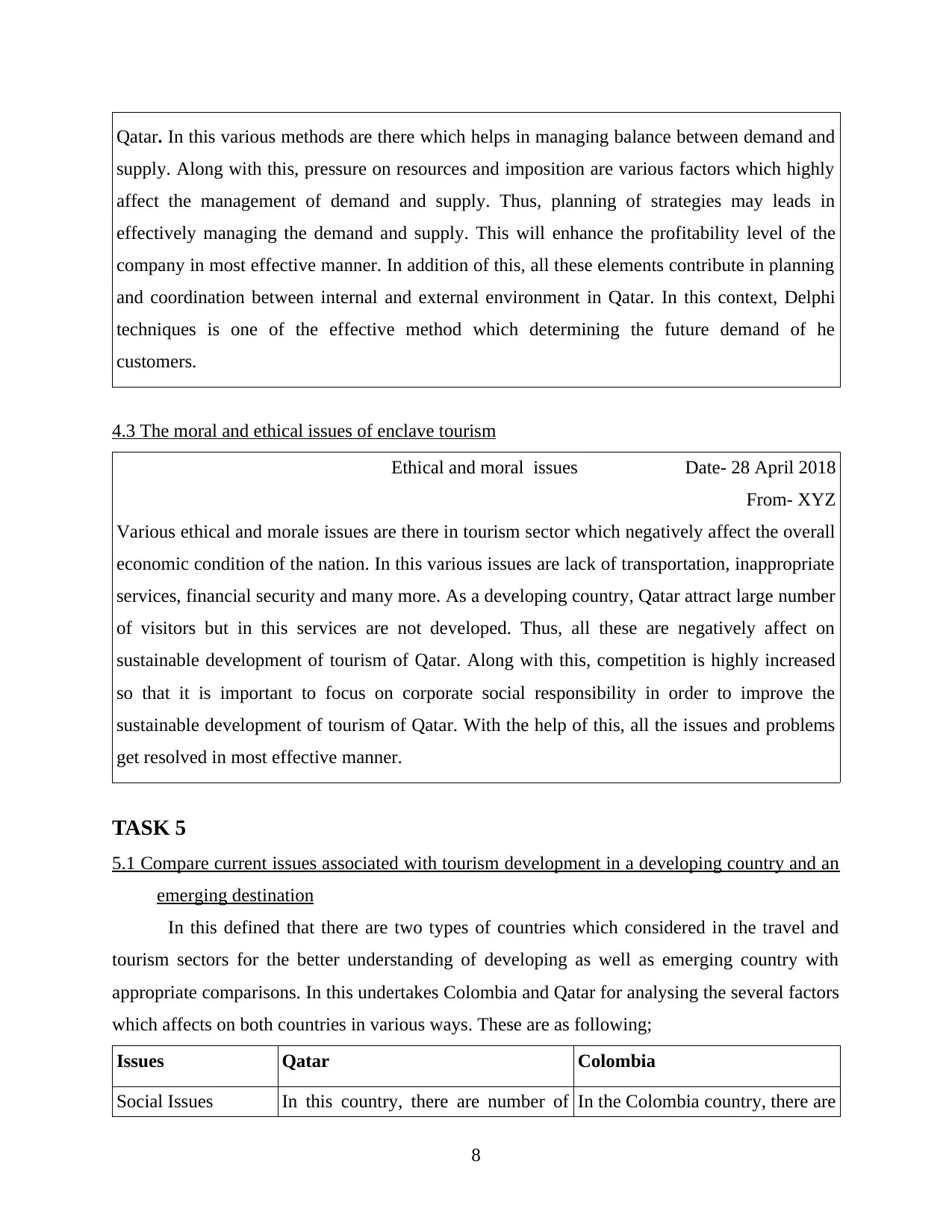
Qatar. In this various methods are there which helps in managing balance between demand and
supply. Along with this, pressure on resources and imposition are various factors which highly
affect the management of demand and supply. Thus, planning of strategies may leads in
effectively managing the demand and supply. This will enhance the profitability level of the
company in most effective manner. In addition of this, all these elements contribute in planning
and coordination between internal and external environment in Qatar. In this context, Delphi
techniques is one of the effective method which determining the future demand of he
customers.
4.3 The moral and ethical issues of enclave tourism
Ethical and moral issues Date- 28 April 2018
From- XYZ
Various ethical and morale issues are there in tourism sector which negatively affect the overall
economic condition of the nation. In this various issues are lack of transportation, inappropriate
services, financial security and many more. As a developing country, Qatar attract large number
of visitors but in this services are not developed. Thus, all these are negatively affect on
sustainable development of tourism of Qatar. Along with this, competition is highly increased
so that it is important to focus on corporate social responsibility in order to improve the
sustainable development of tourism of Qatar. With the help of this, all the issues and problems
get resolved in most effective manner.
TASK 5
5.1 Compare current issues associated with tourism development in a developing country and an
emerging destination
In this defined that there are two types of countries which considered in the travel and
tourism sectors for the better understanding of developing as well as emerging country with
appropriate comparisons. In this undertakes Colombia and Qatar for analysing the several factors
which affects on both countries in various ways. These are as following;
Issues Qatar Colombia
Social Issues In this country, there are number of In the Colombia country, there are
8
supply. Along with this, pressure on resources and imposition are various factors which highly
affect the management of demand and supply. Thus, planning of strategies may leads in
effectively managing the demand and supply. This will enhance the profitability level of the
company in most effective manner. In addition of this, all these elements contribute in planning
and coordination between internal and external environment in Qatar. In this context, Delphi
techniques is one of the effective method which determining the future demand of he
customers.
4.3 The moral and ethical issues of enclave tourism
Ethical and moral issues Date- 28 April 2018
From- XYZ
Various ethical and morale issues are there in tourism sector which negatively affect the overall
economic condition of the nation. In this various issues are lack of transportation, inappropriate
services, financial security and many more. As a developing country, Qatar attract large number
of visitors but in this services are not developed. Thus, all these are negatively affect on
sustainable development of tourism of Qatar. Along with this, competition is highly increased
so that it is important to focus on corporate social responsibility in order to improve the
sustainable development of tourism of Qatar. With the help of this, all the issues and problems
get resolved in most effective manner.
TASK 5
5.1 Compare current issues associated with tourism development in a developing country and an
emerging destination
In this defined that there are two types of countries which considered in the travel and
tourism sectors for the better understanding of developing as well as emerging country with
appropriate comparisons. In this undertakes Colombia and Qatar for analysing the several factors
which affects on both countries in various ways. These are as following;
Issues Qatar Colombia
Social Issues In this country, there are number of In the Colombia country, there are
8
Paraphrase This Document
Need a fresh take? Get an instant paraphrase of this document with our AI Paraphraser
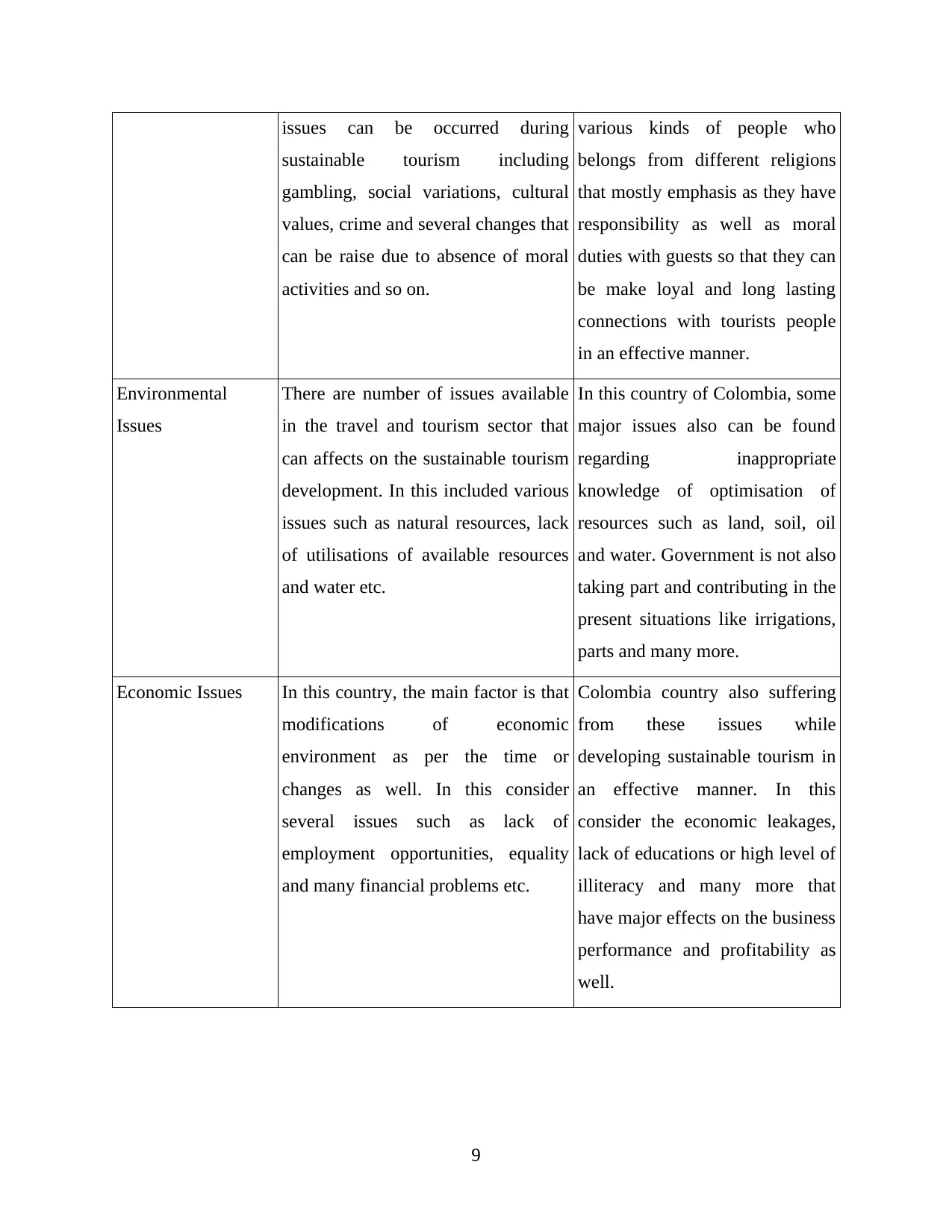
issues can be occurred during
sustainable tourism including
gambling, social variations, cultural
values, crime and several changes that
can be raise due to absence of moral
activities and so on.
various kinds of people who
belongs from different religions
that mostly emphasis as they have
responsibility as well as moral
duties with guests so that they can
be make loyal and long lasting
connections with tourists people
in an effective manner.
Environmental
Issues
There are number of issues available
in the travel and tourism sector that
can affects on the sustainable tourism
development. In this included various
issues such as natural resources, lack
of utilisations of available resources
and water etc.
In this country of Colombia, some
major issues also can be found
regarding inappropriate
knowledge of optimisation of
resources such as land, soil, oil
and water. Government is not also
taking part and contributing in the
present situations like irrigations,
parts and many more.
Economic Issues In this country, the main factor is that
modifications of economic
environment as per the time or
changes as well. In this consider
several issues such as lack of
employment opportunities, equality
and many financial problems etc.
Colombia country also suffering
from these issues while
developing sustainable tourism in
an effective manner. In this
consider the economic leakages,
lack of educations or high level of
illiteracy and many more that
have major effects on the business
performance and profitability as
well.
9
sustainable tourism including
gambling, social variations, cultural
values, crime and several changes that
can be raise due to absence of moral
activities and so on.
various kinds of people who
belongs from different religions
that mostly emphasis as they have
responsibility as well as moral
duties with guests so that they can
be make loyal and long lasting
connections with tourists people
in an effective manner.
Environmental
Issues
There are number of issues available
in the travel and tourism sector that
can affects on the sustainable tourism
development. In this included various
issues such as natural resources, lack
of utilisations of available resources
and water etc.
In this country of Colombia, some
major issues also can be found
regarding inappropriate
knowledge of optimisation of
resources such as land, soil, oil
and water. Government is not also
taking part and contributing in the
present situations like irrigations,
parts and many more.
Economic Issues In this country, the main factor is that
modifications of economic
environment as per the time or
changes as well. In this consider
several issues such as lack of
employment opportunities, equality
and many financial problems etc.
Colombia country also suffering
from these issues while
developing sustainable tourism in
an effective manner. In this
consider the economic leakages,
lack of educations or high level of
illiteracy and many more that
have major effects on the business
performance and profitability as
well.
9
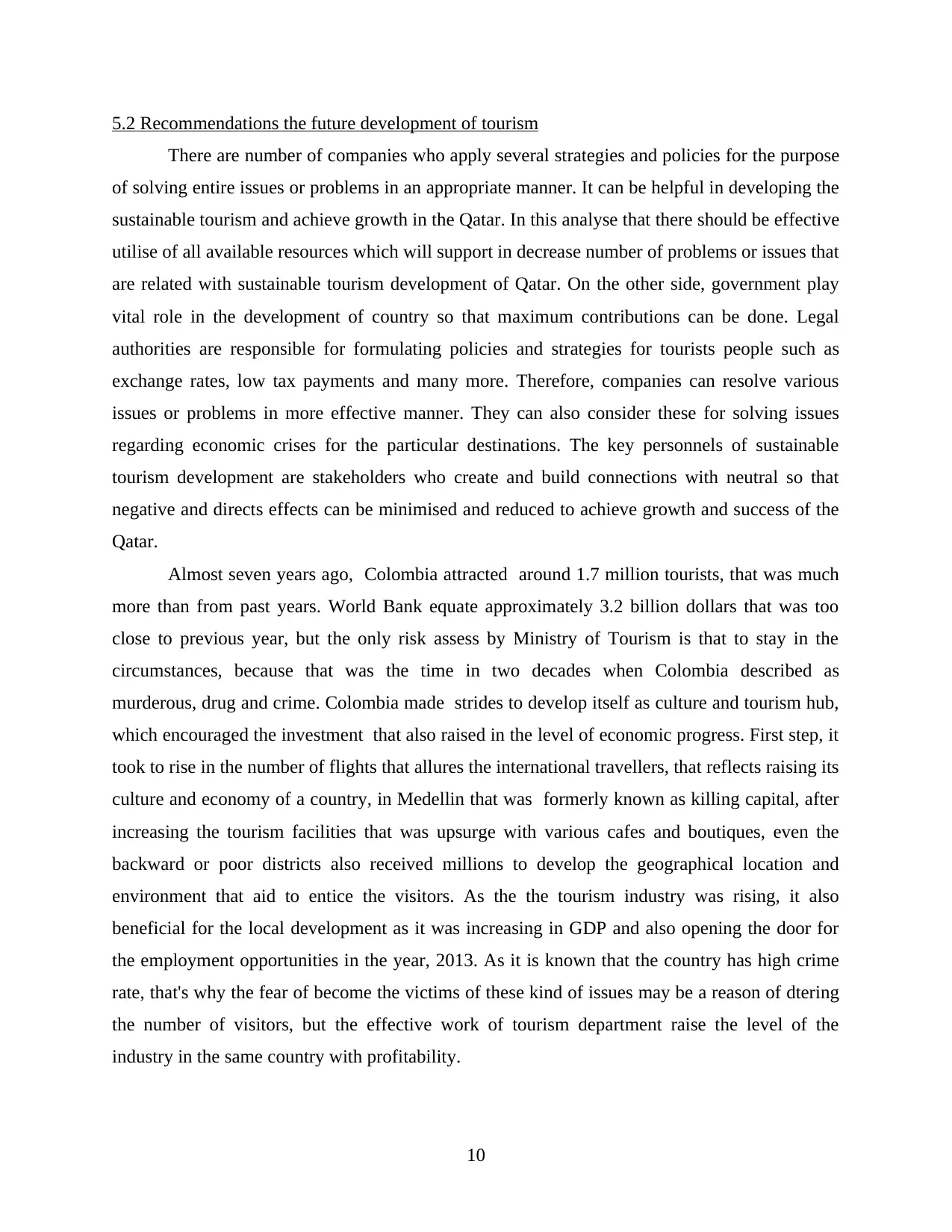
5.2 Recommendations the future development of tourism
There are number of companies who apply several strategies and policies for the purpose
of solving entire issues or problems in an appropriate manner. It can be helpful in developing the
sustainable tourism and achieve growth in the Qatar. In this analyse that there should be effective
utilise of all available resources which will support in decrease number of problems or issues that
are related with sustainable tourism development of Qatar. On the other side, government play
vital role in the development of country so that maximum contributions can be done. Legal
authorities are responsible for formulating policies and strategies for tourists people such as
exchange rates, low tax payments and many more. Therefore, companies can resolve various
issues or problems in more effective manner. They can also consider these for solving issues
regarding economic crises for the particular destinations. The key personnels of sustainable
tourism development are stakeholders who create and build connections with neutral so that
negative and directs effects can be minimised and reduced to achieve growth and success of the
Qatar.
Almost seven years ago, Colombia attracted around 1.7 million tourists, that was much
more than from past years. World Bank equate approximately 3.2 billion dollars that was too
close to previous year, but the only risk assess by Ministry of Tourism is that to stay in the
circumstances, because that was the time in two decades when Colombia described as
murderous, drug and crime. Colombia made strides to develop itself as culture and tourism hub,
which encouraged the investment that also raised in the level of economic progress. First step, it
took to rise in the number of flights that allures the international travellers, that reflects raising its
culture and economy of a country, in Medellin that was formerly known as killing capital, after
increasing the tourism facilities that was upsurge with various cafes and boutiques, even the
backward or poor districts also received millions to develop the geographical location and
environment that aid to entice the visitors. As the the tourism industry was rising, it also
beneficial for the local development as it was increasing in GDP and also opening the door for
the employment opportunities in the year, 2013. As it is known that the country has high crime
rate, that's why the fear of become the victims of these kind of issues may be a reason of dtering
the number of visitors, but the effective work of tourism department raise the level of the
industry in the same country with profitability.
10
There are number of companies who apply several strategies and policies for the purpose
of solving entire issues or problems in an appropriate manner. It can be helpful in developing the
sustainable tourism and achieve growth in the Qatar. In this analyse that there should be effective
utilise of all available resources which will support in decrease number of problems or issues that
are related with sustainable tourism development of Qatar. On the other side, government play
vital role in the development of country so that maximum contributions can be done. Legal
authorities are responsible for formulating policies and strategies for tourists people such as
exchange rates, low tax payments and many more. Therefore, companies can resolve various
issues or problems in more effective manner. They can also consider these for solving issues
regarding economic crises for the particular destinations. The key personnels of sustainable
tourism development are stakeholders who create and build connections with neutral so that
negative and directs effects can be minimised and reduced to achieve growth and success of the
Qatar.
Almost seven years ago, Colombia attracted around 1.7 million tourists, that was much
more than from past years. World Bank equate approximately 3.2 billion dollars that was too
close to previous year, but the only risk assess by Ministry of Tourism is that to stay in the
circumstances, because that was the time in two decades when Colombia described as
murderous, drug and crime. Colombia made strides to develop itself as culture and tourism hub,
which encouraged the investment that also raised in the level of economic progress. First step, it
took to rise in the number of flights that allures the international travellers, that reflects raising its
culture and economy of a country, in Medellin that was formerly known as killing capital, after
increasing the tourism facilities that was upsurge with various cafes and boutiques, even the
backward or poor districts also received millions to develop the geographical location and
environment that aid to entice the visitors. As the the tourism industry was rising, it also
beneficial for the local development as it was increasing in GDP and also opening the door for
the employment opportunities in the year, 2013. As it is known that the country has high crime
rate, that's why the fear of become the victims of these kind of issues may be a reason of dtering
the number of visitors, but the effective work of tourism department raise the level of the
industry in the same country with profitability.
10
⊘ This is a preview!⊘
Do you want full access?
Subscribe today to unlock all pages.

Trusted by 1+ million students worldwide
1 out of 15
Related Documents
Your All-in-One AI-Powered Toolkit for Academic Success.
+13062052269
info@desklib.com
Available 24*7 on WhatsApp / Email
![[object Object]](/_next/static/media/star-bottom.7253800d.svg)
Unlock your academic potential
Copyright © 2020–2025 A2Z Services. All Rights Reserved. Developed and managed by ZUCOL.





